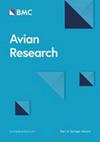Conspecific cues and breeding territory selection in Whinchat on abandoned fields
IF 1.6
2区 生物学
Q1 ORNITHOLOGY
引用次数: 0
Abstract
Many bird species use social information to guide territory selection. Different species in different habitats may use both pre-breeding and post-breeding conspecific cues. Abandoned agricultural fields are of particular interest for studies of conspecific attraction because the ephemeral nature of the habitat suggests territory search just before breeding, but high predation pressure suggests the use of performance-based conspecific cues. We investigated whether post-breeding or pre-breeding social cues affect Whinchat (Saxicola rubetra) abundance at the territorial scale during a two-year experiment in abandoned fields. We assigned 27 experimental plots (3.14 ha) to one of three treatments: post-breeding treatment, pre-breeding treatment and silent control. We conducted playback experiments with fledgling calls (evidence of past reproductive success) during the post-breeding period and male songs (evidence of conspecific presence) during the pre-breeding period. We estimated the difference in Whinchat abundance in two consecutive years and tested whether this value differed between treatment and control plots. We observed a slight increase (0.67 ± 0.29 pairs per plot) in Whinchat abundance in the post-breeding treatment plots and no significant changes in the pre-breeding (−0.22 ± 0.32 pairs per plot) and control (−0.22 ± 0.22 pairs per plot) plots. Our results suggest that Whinchats do not use conspecific acoustic cues during the pre-breeding period and provide limited evidence for the use of fledgling calls as conspecific cues in the post-breeding period.
废弃田地上的同类线索和黄雀的繁殖地选择
许多鸟类利用社会信息来指导领地选择。不同栖息地的不同物种可能会同时使用繁殖前和繁殖后的同种提示。废弃的农田对同种吸引的研究特别有意义,因为这种栖息地的短暂性表明它们在繁殖前会寻找领地,但高捕食压力表明它们会使用基于表现的同种暗示。我们在废弃田地中进行了为期两年的实验,研究了繁殖后或繁殖前的社会线索是否会在领地尺度上影响黄雀(Saxicola rubetra)的数量。我们将 27 块实验田(3.14 公顷)分配到三个处理之一:繁殖后处理、繁殖前处理和无声对照。我们在繁殖后处理期间进行了雏鸟鸣叫(过去繁殖成功的证据)回放实验,在繁殖前处理期间进行了雄鸟鸣叫(同种存在的证据)回放实验。我们估算了连续两年黄雀数量的差异,并测试了处理地块和对照地块之间的差异值。我们观察到,在繁殖后处理地块中,黄雀数量略有增加(每地块 0.67 ± 0.29 对),而在繁殖前处理地块(每地块 -0.22 ± 0.32 对)和对照地块(每地块 -0.22 ± 0.22 对)中,黄雀数量没有显著变化。我们的研究结果表明,黄雀在繁殖前期不使用同种声学线索,并为繁殖后期使用雏鸟叫声作为同种线索提供了有限的证据。
本文章由计算机程序翻译,如有差异,请以英文原文为准。
求助全文
约1分钟内获得全文
求助全文
来源期刊

Avian Research
ORNITHOLOGY-
CiteScore
2.90
自引率
16.70%
发文量
456
审稿时长
46 days
期刊介绍:
Avian Research is an open access, peer-reviewed journal publishing high quality research and review articles on all aspects of ornithology from all over the world. It aims to report the latest and most significant progress in ornithology and to encourage exchange of ideas among international ornithologists. As an open access journal, Avian Research provides a unique opportunity to publish high quality contents that will be internationally accessible to any reader at no cost.
 求助内容:
求助内容: 应助结果提醒方式:
应助结果提醒方式:


